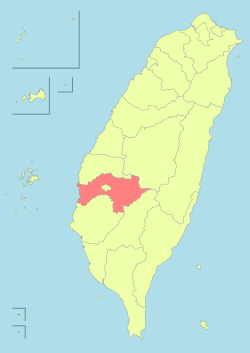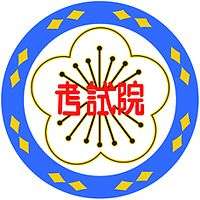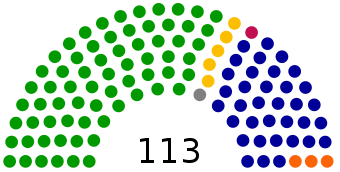Administrative divisions of the Republic of China
| This article is part of a series on |
| Administrative divisions of Taiwan |
|---|
| First-level |
|
| Second-level |
| Third-level |
| Fourth-level |
| Fifth-level |
|
|
Historical divisions of Republic of China (1912–49) Taiwan (1895–1945) |
The Republic of China (ROC), currently governing the Taiwan Area, consists of the four main archipelagos of Taiwan, Penghu, Kinmen, Matsu and some minor islands. The whole country is divided into two streamlined provinces[1] (Taiwan Province and Fujian Province) and six special municipalities (Kaohsiung, New Taipei, Taichung, Tainan, Taipei and Taoyuan). The two streamlined provinces are further subdivided into 3 provincial cities and 13 counties. All special municipalities, provincial cities and counties are placed directly under the jurisdiction of the central government (i.e., Executive Yuan).
History
Early years

The Republic of China was founded on Mainland China in 1912. It used most of the same administrative divisions as the Qing Dynasty but divided Inner Mongolia into four provinces and set up several municipalities under the authority of the Executive Yuan. After the end of World War II in 1945, Manchuria was reincorporated into the Republic of China as nine provinces. Taiwan and the Pescadores were also acquired by the Republic of China and organized into Taiwan Province after Retrocession Day. By this time the top-level divisions consisted of 35 provinces, 12 Yuan-controlled municipalities, one special administrative region and two regions (Mongolia and Tibet). After the central government's strategic withdrawal from mainland China during the Chinese Civil War and subsequent relocation to Taiwan in 1949, the jurisdiction of the ROC was restricted to only Taiwan, the Pescadores, Hainan, and a few offshore islands of Fukien and Chekiang. Hainan fell to the Communists in May 1950 and Chekiang was lost to the Communists in 1955. The remaining area is called the "Free Area of the Republic of China" in the Constitution. In most ordinary legislation, the term "Taiwan Area" is used in place of the "Free Area", while Mainland China is referred to as the "Mainland Area".
Territorial disputes

The Republic of China has never renounced its claim over territory it ruled prior to losing the mainland in 1949. This included all of mainland China, parts of northern Burma, and Tannu Uriankhai (part of which is present-day Tuva in Russia). On May 21, 2012, the Mainland Affairs Council released a press announcement that said that Outer Mongolia is not a part of Republic of China.[2] At the same time, the Republic of China has not recognized any of the changes made by the People's Republic of China to the administrative structure of the mainland. Accordingly, the official first-order divisions of Republic of China remain the historical divisions of China immediately prior to the loss of mainland China. In 1994,[3] the Republic of China consisted of 35 provinces, 1 special administrative region, 2 regions (Tibet and Outer Mongolia), 14 special municipalities, 14 leagues, and 4 special banners. For second-order divisions (under provinces and special administrative regions), there are counties, provincial cities (56), bureaus (34) and management bureaus (7). Under provincial-level municipalities there are districts, and under leagues there are banners (127).
Although the administration of pro-independence President Chen Shui-bian (2000–2008) did not actively claim sovereignty over all of China, the national boundaries of the ROC have not been redrawn. Thus, the claimed area of the ROC continues to include mainland China, several off-shore islands, and Taiwan. Beginning in 2005 the ROC Yearbook, under Chen's administration, ceased displaying official administrative divisions in mainland China.[4] It recognized two provinces (Taiwan and Fukien) and two special municipalities (Taipei and Kaohsiung). President Ma Ying-jeou reasserted the ROC's claim to be the sole legitimate government of China and the claim that mainland China is part of ROC's territory.[5] He does not, however, actively seek reunification, and prefers to maintain an ambiguous status quo in order to improve relations with the PRC.[6]
In practice, although ROC law still formally recognizes residents of mainland China as citizens of the ROC, it makes a distinction between persons who have household residency in the "Free area of the Republic of China" and those that do not, meaning that persons outside the area administered by the ROC must apply for special travel documents and cannot vote in ROC elections.
Changes to divisions on Taiwan
All 12 original special municipalities and the special administrative regions were located in mainland China, and have mostly been abolished by the PRC since the government of the ROC retreated to Taiwan. Since 1949, the ROC government has made some changes in the area under its control. The two provincial governments were streamlined and much of their functions transferred to the central or county governments. Six direct-controlled special municipalities have been created out of territory initially belonging to Taiwan Province.
| Name | Notes |
|---|---|
| Hainan Special Administrative Region | SAR Government was dissolved in 1950, Organic Act abolished in 2003. Jurisdiction of South China Sea Islands were transferred to Kaohsiung City in 1979. |
| Yunnan Province | Provincial Government was relocated in exile to Bangkok in 1950, dissolved in 1951. |
| Chekiang Province | Provincial Government was relocated to Zhoushan Islands in 1950, to Tachen Islands in 1953, in exile to Taipei in 1954, and dissolved in 1955. |
| Sinkiang Province | Provincial Government was relocated in exile to Taipei as the Sinkiang Provincial Government Office in 1949, dissolved in 1992. |
| Fujian Province | The provincial capital was moved from Fuzhou to Jincheng, Kinmen in 1949. Government was streamlined in 1956. |
| Taiwan Province | The provincial capital was moved from Taipei to Zhongxing New Village in 1956. Government streamlined in 1998. |
| Kaohsiung City | Formerly a provincial city of Taiwan Province, was elevated as a special municipality in 1979. In 2010, a new Kaohsiung special municipality was established by merging former Kaohsiung County of Taiwan Province with the existing Kaohsiung City. |
| New Taipei City | Formerly Taipei County of Taiwan Province, was elevated as a special municipality in 2010. |
| Taichung City | Was established by merging Taichung provincial city and Taichung County of Taiwan Province in 2010. |
| Tainan City | Was established by merging Tainan provincial city and Tainan County of Taiwan Province in 2010. |
| Taipei City | Formerly the capital of Taiwan Province, was elevated as a special municipality in 1967. |
| Taoyuan City | Formerly Taoyuan County of Taiwan Province, was elevated as a special municipality in 2014. |
This brought the top-level divisions of the ROC to its current state: 2 streamlined provinces and 6 special municipalities; and under the provinces, 13 counties and three provincial cities.[7]
Special considerations
Streamlining of Provinces
Since 1949, the most controversial part of the political division system of the ROC has been the existence of Taiwan Province, as its existence was part of a larger controversy over the political status of Taiwan. Since 1997, most of the duties and powers of Taiwan Provincial Government have been transferred to the national government of the Republic of China, through amendments to the constitution. The much smaller Fujian province, consisting of Kinmen and Lienchiang, has had most of its authority passed off to its two counties.
| Wikibooks has a book on the topic of: Annotated Republic of China Laws/Additional Articles of the Constitution of the Republic of China/Article 9 |
Joint Service Centers of Executive Yuan
The central government operates three regional Joint Service Centers (區域聯合服務中心) outside Taipei as outposts of the government ministries in the Executive Yuan, similar to the cross-departmental mode of working in the Government Offices in England. These regions, laid out the Comprehensive National Spatial Development Plan for Taiwan (臺灣地區國土綜合開發計劃), can be considered a de facto level of government, perhaps equivalent to de jure provinces or similar to the English regions. There is one regional service center for each of the Southern Taiwan Region (with the center in Kaohsiung), the Central Taiwan Region (Taichung), and the Eastern Taiwan Region (Hualien). The Northern Taiwan Region is served by Taipei, the central government's administrative headquarters and de facto capital.
Re-organization
There has been some criticism of the current administrative scheme as being inefficient and not conducive to regional planning. In particular, most of the administrative cities are much smaller than the actual metropolitan areas, and there are no formal means for coordinating policy between an administrative city and its surrounding areas.
Before 2008, the likelihood of consolidation was low. Many of the cities had political demographics which were very different from their surrounding counties, making the prospect of consolidation highly politically charged. For example, while the Kuomintang argued that combining Taipei City, Taipei County, and Keelung City into a metropolitan Taipei region would allow for better regional planning, the Democratic Progressive Party argued that this was merely an excuse to eliminate the government of Taipei County, which it had at times controlled, by swamping it with votes from Taipei City and Keelung City, which tended to vote Kuomintang.
On 1 October 2007, Taipei County was upgraded to a quasi-municipality (準直轄市) on the same level as Kaohsiung City and Taipei City.[8] This allowed the county to have the organizational and budgetary framework of a de jure municipality, but it was still formally styled as a county. Taichung County and Taichung City lobbied the central government for similar status. Taoyuan County was also upgraded to a quasi-municipality on 1 January 2011, as its population was above 2 million on the date of elevation.[9]
Under President Ma Ying-jeou's administration, the central government has reorganized more counties and cities.[10] The following mergers and promotions were approved in 2009 and became effective on 25 December 2010.[11][12]
- Kaohsiung County was merged with the special municipality of Kaohsiung to form a single special municipality
- Taichung County was merged with the provincial city of Taichung to form a single special municipality
- Tainan County was merged with the provincial city of Tainan to form a single special municipality
- Taipei County was renamed New Taipei and became a special municipality
Proposals for ROC municipalities and counties
Three proposals were not approved in 2009 but may be considered at a later date.
| Proposals | Changes | June 2012 Population - Combine |
Current Area (km²) - Combine |
Map (before) | Map (after) | ||||||
|---|---|---|---|---|---|---|---|---|---|---|---|
| A | Hsinchu City + Hsinchu County = Hsinchu County (新竹市 + 新竹縣 = 新竹縣) |
942,788 | 1,531.6864 |  |
 |
.svg.png) | |||||
| B | Chiayi City + Chiayi County = Chiayi County (嘉義市 + 嘉義縣 = 嘉義縣) |
806,734 | 1,961.6956 |  |
 |
.svg.png) | |||||
| C | Taipei City + New Taipei City + Keelung City = Taipei City (臺北市 + 新北市 + 基隆市 = 臺北市) |
6,967,752 | 2,457.1244 |  |
 |
 |
.svg.png) | ||||
Structural hierarchy
.svg.png)
| Level | 1st | 2nd | 3rd | 4th | 5th |
|---|---|---|---|---|---|
| Division type |
Special municipality (直轄市 zhíxiáshì) (6) | Mountain Indigenous District (山地原住民區 shāndì yuánzhùmín qū) (6) District |
Urban Village (里 lǐ) | Neighborhood (鄰 lín) | |
| Province (省 shěng) (2) (Streamlined) | Provincial city (市 shì) (3) | ||||
| County (縣 xiàn) (13) | County-controlled city (縣轄市 xiànxiáshì) (14) | ||||
| Urban Township (鎮 zhèn) (38) | |||||
| Rural Township (鄉 xiāng) (122) Mountain Indigenous Township |
Rural Village (村 cūn) | ||||
| Total | 22 | 368 | 7,851 | 147,785 | |
Note:
| |||||
Under the ROC administrative scheme, some cities and counties may share the same name but are independent administrations; this occurs with Chiayi City and Chiayi County, and Hsinchu City and Hsinchu County. Generally, special municipalities have the largest administrative area of all three levels of cities, then provincial cities, and finally county-controlled cities, in that order.
Special municipalities
Special municipalities (Chinese: 直轄市; pinyin: zhíxiáshì) are a top-level division in the Republic of China (Taiwan), directly governed by the Executive Yuan. A place with more than 1.25 million residents and with political, economical or cultural importance may become a special municipality.
- There are six special municipalities in Taiwan: Kaohsiung, New Taipei, Taichung, Tainan, Taipei and Taoyuan.
- Note that Kaohsiung also administers the Dongsha Islands and Taiping Island of the South China Sea Islands.
Provincial cities
Provincial cities (Chinese: 市; pinyin: shì) are cities one level lower than special municipalities. Formerly governed by the provinces, they have been directly governed by the Executive Yuan ever since the provinces were streamlined. A place with 0.5 million and 1.25 million residents and with political, economical or cultural importance may become a provincial city.
Counties
Counties (Chinese: 縣; pinyin: xiàn) are one of the administrative division levels under provinces. Formerly governed by the provinces, they have been directly governed by the Executive Yuan ever since the provinces were streamlined. A county with more than two million residents can acquire a status equal to a special municipality.
There are 13 counties in the ROC:
- 10 counties located mainly on the island of Taiwan:
- Penghu County administers Penghu Islands.
- Kinmen County administers Kinmen Islands and Wuqiu Islands.
- Lienchiang County administers Matsu Islands.
Lower-level governance structures
The 22 main divisions in the country are further divided into 368 subdivisions. A County may divided into rural townships (Chinese: 鄉; pinyin: xiāng), urban townships (Chinese: 鎮; pinyin: zhèn) and county-controlled cities (Chinese: 縣轄市; pinyin: xiànxiáshì). A place with more than 150,000 residents may become a county-controlled city. Special municipalities and provincial cities are divided into districts (Chinese: 區; pinyin: qū).
- The 368 subdivisions are classified into: 170 districts, 13 county-controlled cities, 39 urban townships and 146 rural townships.
- The 368 subdivisions are further divided into 7,835 villages and 147,877 neighborhoods.
List of divisions
Romanization
The romanization used for ROC placenames above the county level is a modified form of Wade–Giles, ignoring the apostrophes and hyphens of the original, thus yielding "Taipei" instead of "T'ai-pei" and "Yilan" instead of "I-lan", for example. Some postal romanizations also exist, like "Keelung" and "Kinmen". In 2002, the ROC adopted Tongyong Pinyin as its national standard for romanization. Most townships and county-controlled cities changed their romanization to Tongyong Pinyin at that time. However, some local administrations, like Taipei and Taichung, decided to use Hanyu Pinyin. In 2009, Tongyong Pinyin was replaced by Hanyu Pinyin as the ROC government standard.[13][14] Currently, most of the divisions are romanized by Hanyu Pinyin system, but some local governments still use Tongyong Pinyin, like Kaohsiung. In 2011, the ROC Ministry of the Interior restored historical romanizations for two towns, Lukang and Tamsui.
See also
| Wikimedia Commons has media related to Administrative divisions of Taiwan. |
- History of the Republic of China
- History of Taiwan
- History of the administrative divisions of China (1912–49)
- Political divisions of Taiwan (1895–1945)
- List of administrative divisions of Taiwan
- ISO 3166-2:TW
References
- ↑ Hwang, Jim (October 1999). "Gone with the Times". Taiwan Review. Retrieved 2012-01-11.
- ↑ 有關外蒙古是否為中華民國領土問題說明新聞參考資料
- ↑ 中華民國各省(市)縣(市)行政區域代碼 Archived July 21, 2011, at the Wayback Machine.
- ↑ 中華民國年鑑九十五年版 Archived November 9, 2011, at the Wayback Machine.
- ↑ "Ma refers to China as ROC territory in magazine interview". Taipei Times. 2008-10-08.
- ↑ MacArtney, Jane (2008-08-30). "President Ma Ying-jeou of Taiwan has progress making ties with China". The Times. London.
- ↑ 中華民國國情簡介 政府組織
- ↑ "歷時28年 臺北縣今升格為準直轄市 (After 28 years, Taipei County today is promoted to quasi-municipality status)". 國立教育廣播電台新聞. 2007-10-01. Archived from the original on June 22, 2009.
- ↑ "升格為準直轄市 / 元旦改制日 桃園人口須維持200萬)". Liberty Times. 2010-12-07.
- ↑ "三都十五縣 馬指示漸進推動 (Ma directs gradual progression towards 3 municipalities and 15 counties)". Liberty Times. 2008-12-27. Archived from the original on June 22, 2009.
- ↑ "縣市升格 北中高過關 南縣市補考 (Promotion of Cities and Counties: Taipei, Taichung, and Kaohsiung approved; Tainan awaits further examination)". Liberty Times. 2009-06-24. Archived from the original on June 24, 2009.
- ↑ "臺灣再添直轄市". Wikinews. 2009-06-29.
- ↑ "Hanyu Pinyin to be standard system in 2009". Taipei Times. 2008-09-18.
- ↑ "Gov't to improve English-friendly environment". The China Post. 2008-09-18.
External links
- 內政部地政司 (Department of Land Administration, Ministry of the Interior): Romanizations for county-level and township-level entities
- Fujian Provincial Government
- Taiwan Provincial Government
| This article is part of a series on the |
| Politics of the Republic of China |
|---|
 |
| Commonly known as Taiwan |
|
Leadership |
|
|
|
Other branches 
|
|
Related topics |
|
Taiwan portal |



